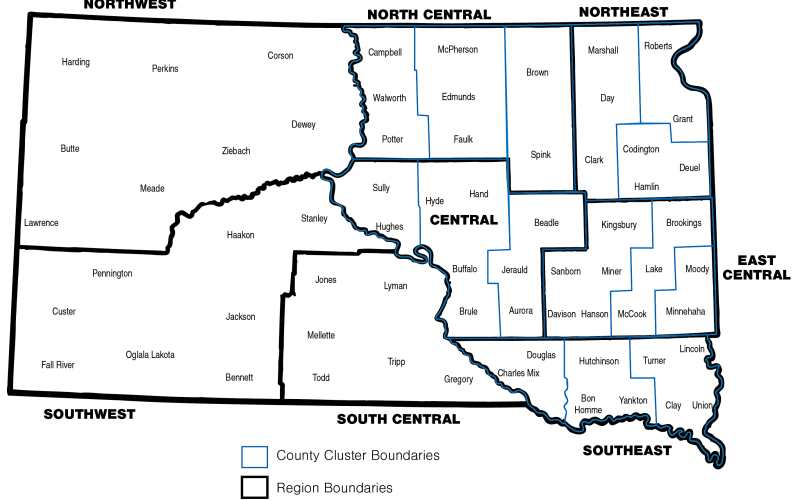The January 2020 South Dakota Crop Progress Report indicated 4 percent of South Dakota’s corn acres remain in the field.
Given the record rainfall of 2019, current snow pack levels and the 3-to-6-month precipitation forecasts, farmers will likely be dealing with a wet spring in 2020, thus making the removal of those acres important but hard to accomplish.
Corn remaining in the field can be good for wildlife feed this winter; however, it will likely pose issues this spring when farmers return to the fields to prepare for planting season. Farmers need to evaluate the options available to them and make the decision that best accomplishes their economic and agronomic goals. It is a bad situation to be in, and an economic hardship to have fields of corn still standing. We want to encourage analysis of many options and the use of the best choice for the farmer.
Options for these acres may include:
Harvest and feed or sell/dispose of the grain.
Depending on the quality of the grain, feeding could be an option. While combining this winter has its own set of challenges, this is one way to get the grain out of the field and knock down stalks. Before feeding is considered, the grain needs to be sent to a laboratory to evaluate moisture content, as well as the presence and level of potential mycotoxins. Weather conditions have been ideal for mycotoxins, including aflatoxins and other quality damaging diseases this year. Their presence and quantity may limit the type of animals the feed can be fed to, as some animals are more sensitive than others. Additional considerations would be where the grain would be stored if drying facilities are not available, as the moisture may be above limits safe to put into grain bins and other storage structures.
Burning.
One way weeds are controlled in pastures is with controlled burns. This option may help eliminate the grain and stalks left in the field. While the fire may not burn every ear, the heat generated could damage the seed enough that it will not germinate. Any residual volunteer growth could be controlled with herbicides. If this option is being considered, coordination between the farmer and the local fire department, as well as neighbors is necessary to prevent accidental burning of non-target areas and ensure those with breathing and other health issues have time to relocate during the burn.
Leave over winter and till under remaining grain and stalks.
This option will provide wildlife feed, and possibly reduce the amount of grain left behind. However, depending on the size of the field and the bushels of grain per acre, the wildlife consumption may not be sufficient and leave a large number of seeds, which can now be considered weeds. These seeds will be introduced into the soil and will need to be controlled either by mechanical or chemical methods. Given the expectation of a wet spring, getting equipment into the field may be hard to accomplish. When soils eventually allow traffic, producers will likely want to use that time to plant, not manage the volunteer corn crop. Herbicide control and soil erosion may also be a concern in this situation due to volunteers and risks associated with bare, disturbed soils. In addition, multiple herbicide passes may be required in this situation, which will increase the cost of production on those acres.
Non-traditional Ethanol Plant Utilization.
While most ethanol plants will not take corn above 20% moisture or grain with any disease or damage issues, there is a plant near Omaha that utilizes a variety of starch-based grains (ex. corn, millet, sorghum). They do not sell their distilled grains for feed use and will buy up to 30% moisture grain with a wide variety of low-quality conditions, including mold. There may be other plants that offer options like this as well. If producers consider this option, trucking costs must be considered and compared to the cost of other removal and utilization options.
Other.
Farmers are creative and may try many other options.
In addition to the cost considerations for each option time and feasibility need to be considered. Snow pack has created an insulating layer on many fields. This insulation may have kept the ground from freezing to a depth that will support combines, trucks or wagons. Thus, the feasibility of options requiring winter removal may be limited due to the continued mud situation.
As the options for producers with standing corn are varied, a cost comparison for each option should be developed. An example is provided in Table 1. To use the comparison the following will need to be estimated:
| Estimates for the example | |
|---|---|
| bu/A in field | 50 bu/A |
| Sale price for feed | $1.00 |
| Sale price for ethanol | $2.00 |
| Miles to feed location | 25 @ $0.004/bu |
| Miles to ethanol plant | 250 @ $0.004/bu |
| Cost to spray herbicide & times | $20/A, twice |
| Combine | $45 |
| Cultivation rate | $15, twice |
| Option Discussed Above |
Combine Cost ($/A) |
Cultivation Rate ($/A) |
Herbicide Rate ($/A) |
Trucking Cost ($/A) |
Sale of Grain ($/A) |
Total Cost/Gain ($/A) |
|---|---|---|---|---|---|---|
| Option 1 | $45.00 | - | - | $ 5.00 | $50.00 | $(0.00) |
| Option 2 | - | - | $40.00 | - | - | $(40.00) |
| Option 3 | - | $30.00 | $40.00 | - | - | $(70.00) |
| Option 4 | $45.00 | - | - | $50.00 | $100.00 | $5.00 |
To discuss your options, contact Sara Bauder, SDSU Extension Agronomy Field Specialist; Gared Shaffer, SDSU Extension Weeds Field Specialist; Connie Strunk, SDSU Extension Plant Pathology Field Specialist; Heather Gessner, SDSU Extension Livestock Business Management Field Specialist; Jack Davis, SDSU Extension Crops Business Management Field Specialist; Adele Harty, SDSU Extension Cow/Calf Field Specialist or Warren Rusche, SDSU Extension Beef Feedlot Management Associate.


